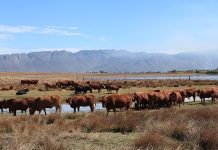Mystery still surrounds the ban on the export of game meat to the EU, which has hit ranchers in the middle of the hunting season and at a time of increasing demand for SA cuts. The ban follows complaints by the EU that tests for chemical residue in the meat did not meet all the requirements.
According to Piet Neethling of Camdeboo Meat Processors in Graaff-Reinet, who is chairperson of the Game Abattoirs and Meat Exporters of SA, a delegation comprised of industry players and representatives of the agriculture department’s veterinary division is scheduled to visit vets this week. “We still don’t know who is responsible for the ban, but believe it was largely caused by a lack of communication between the national agriculture department and the EU,” said Neethling.
“We do believe, however, that has the capacity to do the necessary tests for growth stimulants, that these were done, and that the results were sent to the EU. As far as we are aware, the meat is clean. We don’t know of any local farmers who administer growth stimulants to their game animals.”
Ranchers are hoping that because the crisis was allegedly caused by bad administration and poor paperwork rather than an unsafe product, the ban will be lifted sooner than in the cases of disease threat, when exports can only resume after a waiting period of least three months. Meanwhile, the ban has not only brought the industry to a halt, but is costing the country millions of rands in exports and is putting rural harvesting teams out of work. According to Neethling, a sizable stockpile of carcasses has been building up since the ban and no new carcasses are coming into cool rooms.
“Fortunately refrigerated game meat can keep for three years, but ranchers will now have to depend on biltong hunters and the limited domestic market to buy their surplus animals. This could reduce the on-the-farm price of springbok from R20/kg to R12/kg.” Other export species include kudu, blesbok and impala. S ome farmers have had to cull up to 500 springbok this winter and are also faced with huge overstocking problems as the herds have to be thinned out before the next reproductive cycle.
Francois de Wet, managing director of Mosstrich, a large ostrich and game meat export abattoir, said it’s essential for processors to cooperate with the national agriculture department to have the ban lifted, and to assure the that complies with export regulations. “Naturally, the ban will have a negative impact on industry perceptions. We’ve already stopped all harvesting until we know when the ban will end, but it’s essential to stay positive. After all, the ostrich industry survived after the avian flu scare a few years ago.”
However, De Wet cautioned that it would be difficult to offload surplus game meat on the domestic market. “Despite the marketing campaign to sell more ostrich meat locally, only 10% of the total annual production of 5 500t is sold in the form of prime cuts in our supermarkets.” He also noted that the supply chain of ostrich meat is more integrated from the farm to Europe, as most ostrich farmers are shareholders of export abattoirs and are loyal towards their own supply chain. “But game owners are not committed to specific export units.
They usually harvest only once a year and often jump from one buyer to another, chasing the best price. This makes it difficult for processors to communicate with them to explain an extraordinary situation like this one.” D e Wet added that processors often find it difficult to buy carcasses at realistic prices because they have to compete with live game sales. “It will be difficult to continue harvesting game on the same scale as before, even for the local market.
Although local consumption has increased, many consumers think game meat should be relatively cheap. But the costs of the raw materials, harvesting, transport and processing have also increased, making it impossible to continue harvesting large volumes at export-related, raw-material prices.” espite this, De Wet still feels it’s important to promote local consumption and pointed out that Europe imports large quantities of New Zealand game, but the share of the market is fairly small, with most of our species relatively unknown.
“Springbok sells well, but there’s a long road ahead to successfully market other species in decent quantities,” De Wet said, warning that the can’t be expected to lift the ban overnight because of legal ramifications and red tape. While there’s much debate about promoting fresh game meat locally, no-one in the industry seemed to know what percentage of the annual game cull is sold as biltong or sausage – products that have become expensive delicacies. – Roelof Bezuidenhout








